List of Trapezuntine emperors
This is a list of the Trapezuntine emperors from the foundation of the Empire of Trebizond in 1204 to its fall to the Ottoman Empire in 1461. The Trapezuntine Emperors ruled Trebizond (Greek: Trapezus), one of the three Byzantine Greek states that claimed direct succession to the Byzantine Empire, which had been usurped by the Latin Empire in the aftermath of the Fourth Crusade. Out of the three states, the Empire of Nicaea succeeded in displacing the Latin Emperors in 1261 and restoring the Byzantine Empire under the Palaiologos dynasty. The Empire of Trebizond would come to outlast the restored Empire centered in Constantinople, and continued to use the imperial title, albeit slightly changed, until its fall.
| Emperor of all the East, of the Iberians and of Perateia | |
|---|---|
Imperial | |
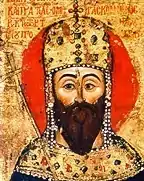 Alexios III 13 December 1349 – 20 March 1390 | |
| Details | |
| First monarch | Alexios I Megas Komnenos |
| Last monarch | David Megas Komnenos |
| Formation | 1204 |
| Abolition | 15 August 1461 |
| Residence | Trebizond |
| Appointer | Not specified, de facto hereditary[1] |
The Byzantine Empire was the direct legal continuation of the eastern half of the Roman Empire following the division of the Roman Empire in 395. As such, the Byzantine Emperors continued to style themselves as "Roman Emperors", the term "Byzantine" being coined by Western historiography in the 16th century, long after the Empire had fallen. By the time of the Fourth Crusade, the standard title used by the Byzantine ruler was "[Name] in Christ the God, faithful Emperor and Autocrat of the Romans" (in Greek: [Name] ἐν Χριστῷ τῷ Θεῷ, πιστός βασιλεὺς καὶ αὐτοκράτωρ Ῥωμαῖων). This title was adopted by the Emperors of both Nicaea and Trebizond in 1204 following the establishment of the Latin Empire, and by the short-lived Empire of Thessalonica in 1225, becoming rival claimants to the Roman imperial title.[2]
After the recapture of Constantinople by Michael VIII Palaiologos of Nicaea in 1261, envoys were sent to John II of Trebizond, requesting that he cease using the imperial emblems and titles, and offering the third daughter of the Emperor, Eudokia, in marriage along with the title of Despot. John married Eudokia in Constantinople in 1282. From then on, the Trapezuntine rulers adopted the formula "in Christ the God, faithful Emperor and Autocrat of all the East, of the Iberians and of Perateia" (ἐν Χριστῷ τῷ Θεῷ, πιστός βασιλεὺς καὶ αὐτοκράτωρ πάσης Ἀνατολῆς, Ἰβήρων καὶ Περατείας), rather than "... of the Romans". This title first appears in legislative texts in the signature on a chrysobull by Alexios III.[2] "Of all the East" and "of the Iberians" are overstatements seeing as the region of Iberia (referring to caucasian Iberia, or "Kartli", not to the Iberian Peninsula) itself had already been lost by the Empire at this point. "Perateia", which was preserved in the title until the very end of the Empire (unlike "Iberia" which was dropped c. 1334), refers to the lands under Imperial rule in the Crimean peninsula.[2]
The rulers of Trebizond also styled themselves as Megas Komnenos ("Grand Komnenos") to emphasize their descent from the Komnenos dynasty, which had ruled the Byzantine Empire in 1081–1185.[3]
Byzantine authors, such as Pachymeres, and to some extent Trapezuntines such as Lazaropoulos and Bessarion, regarded the Trapezuntine Empire as being no more than a Lazian border state. Thus from the point of view of many of the Byzantine writers, particularly those connected with the ruling Laskaris and later Palaiologos dynasties, the rulers of Trebizond were not emperors.[4][5]
List of Emperors
| Name | Reign | Notes | |
|---|---|---|---|
| Alexios I Megas Komnenos (Αλέξιος Α΄ Μέγας Κομνηνός) |
1204 – 1 February 1222 |
Founded the Empire of Trebizond shortly prior to the fall of Constantinople in 1204 to the Fourth Crusade. Alexios and his brother David were the last male descendants of Byzantine Emperor Andronikos I, who had been deposed in 1185, and thus claimed to represent the legitimate Roman government in opposition to both the Latin Empire and the Empire of Nicaea. | |
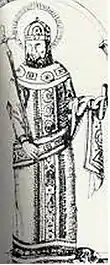 |
Andronikos I Gidos (Ανδρόνικος Α΄ Γίδος) |
1222 – 1235 |
The only emperor not to share blood relation with the founder of the Empire, Alexios I. Became emperor through marriage with a daughter of Alexios I. During his reign, Trebizond successfully withstood a siege of the city by the Seljuk Turks, and later supported the Shah of Khwarizm in the latter's unsuccessful battle with the Seljuks. |
| John I Axouchos (Ιωάννης Α΄ Αξούχος) |
1235 – 1238 |
The eldest son of Alexios I. Little is recorded of the reign of John I, he died while playing tzykanion, a variant of polo fashionable among the Byzantine nobility, when he fell from his horse and was trampled to death.[6] | |
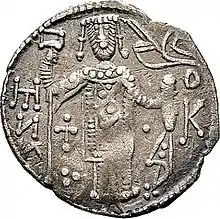 |
Manuel I Megas Komnenos (Μανουήλ Α΄ Μέγας Κομνηνός) |
1238 – March 1263 |
Known as "The Most Fortunate" and "The Great Captain". A younger son of Alexios I. Led a joint defensive campaign against the Mongol Empire, assisting forces of the Seljuk Sultanate of Rûm and the Empire of Nicaea. Visited the Great Khan Güyük in person, becoming a nominal Mongol vassal. Other important events during his reign include a catastrophic fire in the city of Trebizond in 1253 and the recovery of Sinope from the Seljuks in 1254. |
| Andronikos II Megas Komnenos (Ανδρόνικος Β΄ Μέγας Κομνηνός) |
March 1263 – 1266 |
Son of Manuel I. The reign of Andronikos II saw the permanent loss of Sinope to the Seljuk Turks, which gave them access to the best port on the Black Sea and allowed for the construction of a powerful Turkish navy that competed with the Trapezuntine state for control and influence in the Black Sea. | |
| George Megas Komnenos (Γεώργιος Μέγας Κομνηνός) |
1266 – 1280 |
Son of Manuel I and half-brother of Andronikos II. Was betrayed and deposed by his brother John II, but returned in 1284 in a failed attempt at recovering his throne. | |
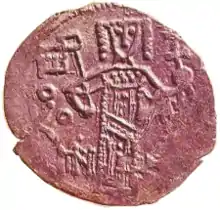 |
John II Megas Komnenos (Ιωάννης Β΄ Μέγας Κομνηνός) |
1280 – 1284 1285 – 1297 |
Son of Manuel I, half-brother of Andronikos II and brother of Georgios. John II changed the imperial title from the traditional "Emperor and Autocrat of the Romans" to "Emperor and Autocrat of all the East, of the Iberians and of Perateia" to appeal to the resurgent Byzantine Empire under the Palaiologos dynasty. The reign of John II also saw increasing attention from powers in western Europe, with John being invited to partake in a new crusade and to serve as Christianity's ambassadors to the Mongols by Pope Nicholas IV. John II was momentarily deposed by his sister Theodora 1284-1285, taking refuge in Tripolis until he shortly thereafter retook the throne. |
| Theodora Megale Komnene (Θεοδώρα Μεγάλη Κομνηνή) |
1284 – 1285 |
Daughter of Manuel I and younger sister of John II. Usurped the throne of Trebizond from her brother with the aid of Imeretian king David VI. Her short reign ended with the return of John to the throne. Theodora is the only Trapezuntine Empress to have coined money in her name.[7] | |
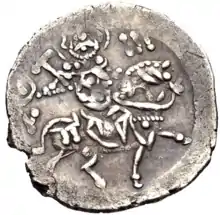 |
Alexios II Megas Komnenos (Αλέξιος Β΄ Μέγας Κομνηνός) |
16 August 1297 – 3 May 1330 |
Eldest son of John II and his wife Eudokia Palaiologina. The Empire of Trebizond reached the climax of its prosperity under Alexios II, who also rebuffed invasions from the Seljuk Turks and handled encroachment from the Italian merchant republics of Genoa and Venice. Alexios also cultivated the arts and sciences of his court, serving as patron to Byzantine astronomers and scholars.[8] |
| Andronikos III Megas Komnenos (Ανδρόνικος Γ΄ Μέγας Κομνηνός) |
October 1330 – 8 January 1332 |
Son of Alexios II. Ruled for fifteen months. Andronikos put his younger brothers Georgios and Michael to death, but failed to kill his brother Basil, who escaped to Constantinople. | |
| Manuel II Megas Komnenos (Μανουήλ Β΄ Μέγας Κομνηνός) |
8 January 1332 – September 1332 |
Son of Andronikos III, ruled for eight months during 1332 before Basil, brother of Andronikos III, returned to Trebizond and took over the government and exiled the eight-year old Manuel to a monastery. Manuel was murdered a year later, possibly on the order of Basil. | |
 |
Basil Megas Komnenos (Βασίλειος Μέγας Κομνηνός) |
September 1332 – 6 August 1340 |
Son of Alexios II and brother of Andronikos III. Secured a marriage alliance with Byzantine Emperor Andronikos III Palaiologos by marrying his illegitimate daughter Irene Palaiologina. |
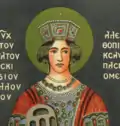 |
Irene Palaiologina (Ειρήνη Παλαιολογίνα) |
6 August 1340 – 17 July 1341 |
Widow of Basil. Possibly poisoned Basil to seize the throne. Her rule was tenuous as she was not a member of the ruling Megas Komnenos dynasty. After a brief civil war, Irene was deposed by Anna, sister of Basil. |
| Anna Anachoutlou (Αννα Αναcηοθτλοθ) |
17 July 1341 – 4 September 1342 |
Daughter of Alexios II and sister of Basil. Deposed Irene Palaiologina, but was after just over a year of rule deposed herself in a popular revolt in favor of John III, son of Michael who was in turn the son of Emperor John II. Anna was strangled to death soon after her deposition. | |
 |
John III Megas Komnenos (Ἰωάννης Γ΄ Μέγας Κομνηνός) |
4 September 1342 – 3 May 1344 |
Grandson of John II. Was deposed in favor of his father Michael in 1344, being banished to the monastery of St. Sabbas. John was later transferred to Constantinople, but escaped c. 1357 and attempted to regain his throne, only to die around 1362. |
 |
Michael Megas Komnenos (Μιχαήλ Μέγας Κομνηνός) |
3 May 1344 – 13 December 1349 |
Father of John III and son of John II. The reign of Michael saw a severe weakening of the Empire due to the Black Death raging within its borders, increasing conflicts with the Genoese who came to dominate more and more of the lucrative Black Sea trade and invasions by the Turkmen. After five years of rule, Michael was deposed and his nephew John, who took the name Alexios III, was crowned emperor in his stead. Michael was imprisoned, later being a prisoner of Byzantine Emperor John VI. He was released in 1355 and attempted to regain his throne, but failed and returned to Constantinople, where he died. |
 |
Alexios III Megas Komnenos (Αλέξιος Γ΄ Μέγας Κομνηνός) |
13 December 1349 – 20 March 1390 |
Nephew of Michael and son of Basil. Alexios III is perhaps the best documented Trapezuntine emperor due to the large number of religious grants and literary creations composed during his reign. Fostered diplomatic relations with the Byzantine Empire and the Turkmen of Aq Qoyunlu. Alexios also attempted to displace the dominant position of the Genoese in Black Sea trade affairs by restoring commercial relations with their rival, Venice. |
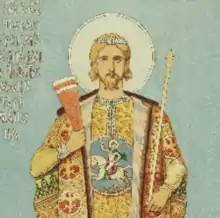 |
Manuel III Megas Komnenos (Μανουήλ Γ΄ Μέγας Κομνηνός) |
20 March 1390 – 5 March 1417 |
Son of Alexios III. The reign of Manuel saw the growing Ottoman Empire becoming an increasing threat. The Ottoman defeat in the Battle of Ankara against the Timurids in 1402 extended the life and security of the Trapezuntine Empire for several more decades. |
| Alexios IV Megas Komnenos (Αλέξιος Δ΄ Μέγας Κομνηνός) |
5 March 1417 – October 1429 |
Son of Manuel III. Though he had received the title of "Despot" by his father as early as 1395, Alexios was eager to assume supreme power and is believed by some to have hastened the death of his father. His reign saw conflict with the Genoese, but good relations with Venice. His son John revolted; when Alexios left the city of Trebizond to meet with him he was murdered by nobles who supported John. | |
| John IV Megas Komnenos (Ιωάννης Δ΄ Μέγας Κομνηνός) |
October 1429 – 1460 |
Son of Alexios IV. The reign of John saw increasing threats from the Turkmen neighbors of the Empire and the Ottoman Empire in the west. The Fall of Constantinople and end of the Byzantine Empire in 1453 left the Empire of Trebizond as the last remnant of the Roman imperial tradition and John pursued diplomatic negotiations to attempt to secure himself against an impending Ottoman conquest. John married his daughter Theodora to Uzun Hasan of the Aq Qoyunlu and was the first Trapezuntine emperor to respond to papal letters, hoping for a union between the churches that could help in resisting the Ottomans. His brother Alexander was briefly co-emperor c. 1451-1459. | |
| David Megas Komnenos (Δαβίδ Μέγας Κομνηνός) |
1460 – 15 August 1461 |
Son of Alexios IV and brother of John IV. David surrendered after a siege of Trebizond by the Ottomans, in return for a comfortable retirement in Thrace with his family. David lived for two years in Adrianople, before Mehmed II imprisoned and beheaded him and his sons. His surrender marks the end of the Roman imperial tradition. | |
Trapezuntine Family Tree
| Family Tree of Trapezuntine Emperors | |||||||||||||||||||||||||||||||||||||||||||||||||||||||||||||||||||||||||||||||||||||||||||||||||||||||||||||||||||||||||||||||||||||||||||||||||||||||||||||||||||||||||||||||||||||||||||||||||||||||||||||||||||||||||||||||||||||||||||||||||||||||||||||||||||||||||||||||||||||||||||||||||||||||||||||||||||||||||||||||||||||||||||||||||||||||||||||||||||||||||||||||||||||||||||||||||||||||||||||||||||||||||||||||||||||||||||||||||||||||||||||||||||||||||||||||||||||||||||||||||||||||||||||||||||||||||||||||||||||||||||||||||||||||||||||||||||||||||||||||||||||||||||||||||||||||||||||||||||||||||||||||||||||||||||||||||||||||||||||||||||||||||||||||||||||||||||||||||||||||||||||||||||||||||||||||||||||||||||||||||||||||||||||||||||||||||||||||||||||||||||||||||||||||||||||||||||||||||||||||||||||||||||||||||||||||||||||||||||||||||||||||||||||||||||||||||||||||||||||||||||||||||||||||||||||||||||||||||||||||||||||||||||||||||||||||||||||||||||||||||||||||||||||||||||||||||||||||||||||||
|---|---|---|---|---|---|---|---|---|---|---|---|---|---|---|---|---|---|---|---|---|---|---|---|---|---|---|---|---|---|---|---|---|---|---|---|---|---|---|---|---|---|---|---|---|---|---|---|---|---|---|---|---|---|---|---|---|---|---|---|---|---|---|---|---|---|---|---|---|---|---|---|---|---|---|---|---|---|---|---|---|---|---|---|---|---|---|---|---|---|---|---|---|---|---|---|---|---|---|---|---|---|---|---|---|---|---|---|---|---|---|---|---|---|---|---|---|---|---|---|---|---|---|---|---|---|---|---|---|---|---|---|---|---|---|---|---|---|---|---|---|---|---|---|---|---|---|---|---|---|---|---|---|---|---|---|---|---|---|---|---|---|---|---|---|---|---|---|---|---|---|---|---|---|---|---|---|---|---|---|---|---|---|---|---|---|---|---|---|---|---|---|---|---|---|---|---|---|---|---|---|---|---|---|---|---|---|---|---|---|---|---|---|---|---|---|---|---|---|---|---|---|---|---|---|---|---|---|---|---|---|---|---|---|---|---|---|---|---|---|---|---|---|---|---|---|---|---|---|---|---|---|---|---|---|---|---|---|---|---|---|---|---|---|---|---|---|---|---|---|---|---|---|---|---|---|---|---|---|---|---|---|---|---|---|---|---|---|---|---|---|---|---|---|---|---|---|---|---|---|---|---|---|---|---|---|---|---|---|---|---|---|---|---|---|---|---|---|---|---|---|---|---|---|---|---|---|---|---|---|---|---|---|---|---|---|---|---|---|---|---|---|---|---|---|---|---|---|---|---|---|---|---|---|---|---|---|---|---|---|---|---|---|---|---|---|---|---|---|---|---|---|---|---|---|---|---|---|---|---|---|---|---|---|---|---|---|---|---|---|---|---|---|---|---|---|---|---|---|---|---|---|---|---|---|---|---|---|---|---|---|---|---|---|---|---|---|---|---|---|---|---|---|---|---|---|---|---|---|---|---|---|---|---|---|---|---|---|---|---|---|---|---|---|---|---|---|---|---|---|---|---|---|---|---|---|---|---|---|---|---|---|---|---|---|---|---|---|---|---|---|---|---|---|---|---|---|---|---|---|---|---|---|---|---|---|---|---|---|---|---|---|---|---|---|---|---|---|---|---|---|---|---|---|---|---|---|---|---|---|---|---|---|---|---|---|---|---|---|---|---|---|---|---|---|---|---|---|---|---|---|---|---|---|---|---|---|---|---|---|---|---|---|---|---|---|---|---|---|---|---|---|---|---|---|---|---|---|---|---|---|---|---|---|---|---|---|---|---|---|---|---|---|---|---|---|---|---|---|---|---|---|---|---|---|---|---|---|---|---|---|---|---|---|---|---|---|---|---|---|---|---|---|---|---|---|---|---|---|---|---|---|---|---|---|---|---|---|---|---|---|---|---|---|---|---|---|---|---|---|---|---|---|---|---|---|---|---|---|---|---|---|---|---|---|---|---|---|---|---|---|---|---|---|---|---|---|---|---|---|---|---|---|---|---|---|---|---|---|---|---|---|---|---|---|---|---|---|---|---|---|---|---|---|---|---|---|---|---|---|---|---|---|---|---|---|---|---|---|---|---|---|---|---|---|---|---|---|---|---|---|---|---|---|---|---|---|---|---|---|---|---|---|---|---|---|---|---|---|---|---|---|---|---|---|---|---|---|---|---|---|---|---|---|---|---|---|---|---|---|---|---|---|---|---|---|---|---|---|---|---|---|---|---|---|---|---|---|---|---|---|---|---|---|---|---|---|---|---|---|---|---|---|---|---|---|---|---|---|---|---|---|---|---|---|---|---|---|---|---|---|---|---|---|---|---|---|---|---|---|---|---|---|---|---|---|---|---|---|---|---|---|---|---|---|---|---|---|---|---|---|---|---|---|---|---|---|---|---|---|---|---|---|---|---|---|---|---|---|---|---|---|---|---|---|---|---|---|---|---|---|---|---|---|---|---|---|---|---|---|---|---|---|---|---|---|---|---|---|---|---|---|---|---|---|---|---|---|---|---|---|---|---|---|---|---|---|---|---|---|---|---|---|---|---|---|---|---|---|---|---|---|---|---|---|---|---|---|---|---|---|---|---|---|---|---|---|---|---|---|---|---|---|---|---|---|---|---|---|---|---|---|---|---|---|---|---|---|---|---|---|---|---|---|---|---|---|---|---|---|---|---|---|---|---|---|---|---|---|---|---|---|---|---|---|---|---|---|---|---|---|---|---|---|---|---|---|---|---|---|---|---|---|---|---|---|---|---|---|---|
| |||||||||||||||||||||||||||||||||||||||||||||||||||||||||||||||||||||||||||||||||||||||||||||||||||||||||||||||||||||||||||||||||||||||||||||||||||||||||||||||||||||||||||||||||||||||||||||||||||||||||||||||||||||||||||||||||||||||||||||||||||||||||||||||||||||||||||||||||||||||||||||||||||||||||||||||||||||||||||||||||||||||||||||||||||||||||||||||||||||||||||||||||||||||||||||||||||||||||||||||||||||||||||||||||||||||||||||||||||||||||||||||||||||||||||||||||||||||||||||||||||||||||||||||||||||||||||||||||||||||||||||||||||||||||||||||||||||||||||||||||||||||||||||||||||||||||||||||||||||||||||||||||||||||||||||||||||||||||||||||||||||||||||||||||||||||||||||||||||||||||||||||||||||||||||||||||||||||||||||||||||||||||||||||||||||||||||||||||||||||||||||||||||||||||||||||||||||||||||||||||||||||||||||||||||||||||||||||||||||||||||||||||||||||||||||||||||||||||||||||||||||||||||||||||||||||||||||||||||||||||||||||||||||||||||||||||||||||||||||||||||||||||||||||||||||||||||||||||||||||
See also
- Empire of Trebizond
- List of consorts of the Byzantine successor states
- List of Byzantine emperors
- List of Roman emperors
- List of Roman usurpers
- List of Byzantine usurpers
- List of Roman and Byzantine Empresses
References
- Nicol, Donald MacGillivray, Last Centuries of Byzantium, 1261-1453, Cambridge University Press, Second Edition, 1993, p. 72: "Hereditary succession to the throne was a custom or a convenience in Byzantium, not an inviolable principle. Emperors, particularly in the later period, would take pains to nominate their sons as co-emperors, for the rule of a dynasty made for stability and continuity. But in theory, the road to the throne was a carriere ouverte aux talents [career open to talents]..."
- "Establishment of the Empire of Trebizond by the Grand Komnenoi, 1204". Encyclopaedia of the Hellenic World, Asia Minor. Foundation of the Hellenic World. Retrieved 2018-01-21.
- R. Macrides, "What's in the name 'Megas Komnenos'?" Archeion Pontou 35 (1979), pp. 238–245
- Finlay, George. The History Of Greece From Its Conquest By The Crusaders To Its Conquest By The Turks And Of The Empire Of Trebizond, 1204-1461, By George Finlay. 1st ed. Edinburgh: W. Blackwood and sons, 1851. Print.
- Vasilev, A. A. The Foundation Of The Empire Of Trebizond 1204-1222. 1st ed. Cambridge, Mass.: Medieval Academy of America, 1936. Print.
- George Finlay (The History of Greece and the Empire of Trebizond, (1204-1461), (Edinburgh: William Blackwood, 1851), p. 338 n. 1) discusses the possible locations of the hippodrome of Trebizond where John died.
- Warwick Wroth, Catalogue of the Coins of the Vandals, Ostrogoths and Lombards and of the Empires of Thessalonica, Nicaea and Trebizond in the British Museum (London: Trustees of the British Museum, 1911), pp. lxxx, 277 has only an example of the asper; Otto Retowski, Die Muenzen der Komnen von Trapezunt, 1910 (Braunschweig: Klinkhardt & Biermann, 1974), pp. 132-134 shows two examples of both asper and nomisma.
- Zehiroğlu, A.M. "Astronomy in the Trebizond Empire", (2016), pp. 2–5